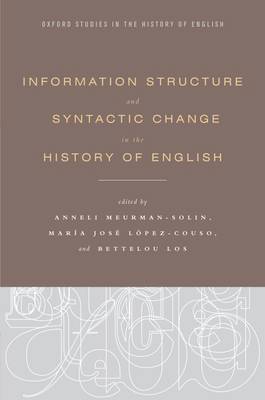
Door een staking bij bpost kan je online bestelling op dit moment iets langer onderweg zijn dan voorzien. Dringend iets nodig? Onze winkels ontvangen jou met open armen!
- Afhalen na 1 uur in een winkel met voorraad
- Gratis thuislevering in België vanaf € 30
- Ruim aanbod met 7 miljoen producten
Door een staking bij bpost kan je online bestelling op dit moment iets langer onderweg zijn dan voorzien. Dringend iets nodig? Onze winkels ontvangen jou met open armen!
- Afhalen na 1 uur in een winkel met voorraad
- Gratis thuislevering in België vanaf € 30
- Ruim aanbod met 7 miljoen producten
Zoeken
Information Structure and Syntactic Change in the History of English
Anneli (Professor of Linguistics, Professor of Linguistics, Univ, Maria Jose (Senior Lecturer, Senior Lecturer, Universidad de San, Bettelou (Professor of Linguistics, Professor of Linguistics, Ra
€ 225,95
+ 451 punten
Omschrijving
Information Structure and Syntactic Change in the History of English is the first book to apply information structure as it relates to language change to a corpus-based analysis of a wide range of features in the evolution of English syntax and grammars of prose in long diachrony. Its unifying topic is the role of information structure, broadly conceived, as it interacts with the other levels of linguistic description, syntax, morphology, prosody, semantics and pragmatics. The volume comprises twelve chapters by leading scholars who take a variety of theoretical and methodological approaches. Their work affirms, among other things, that motivations for selecting a particular syntactic option vary from information structure in the strict sense to discourse organization, or a particular style or register, and can also be associated with external forces such as the development of a literary culture.
Specificaties
Betrokkenen
- Auteur(s):
- Uitgeverij:
Inhoud
- Aantal bladzijden:
- 352
- Taal:
- Engels
- Reeks:
Eigenschappen
- Productcode (EAN):
- 9780199860210
- Verschijningsdatum:
- 11/07/2012
- Uitvoering:
- Hardcover
- Formaat:
- Genaaid
- Afmetingen:
- 157 mm x 236 mm
- Gewicht:
- 589 g

Alleen bij Standaard Boekhandel
+ 451 punten op je klantenkaart van Standaard Boekhandel
Beoordelingen
We publiceren alleen reviews die voldoen aan de voorwaarden voor reviews. Bekijk onze voorwaarden voor reviews.











